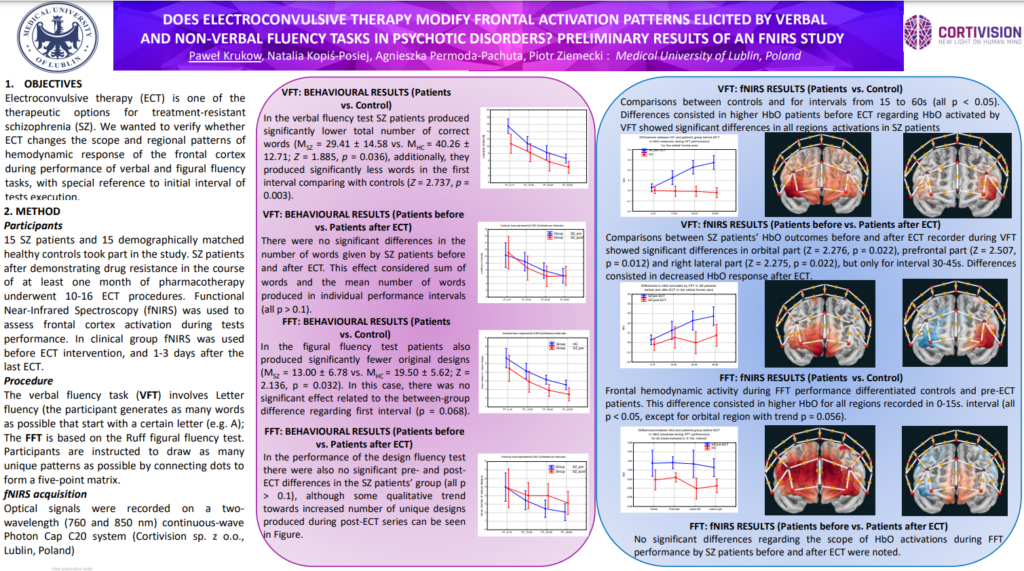Electroconvulsive therapy (ECT) is one of the primary treatments for severe mood and psychotic disorders. The current practice of ECT refers to applied, brief general anesthesia, usually lasting less than 10 minutes. An electrical charge is then delivered to the brain via electrodes on the scalp, resulting in a generalized convulsive seizure, usually lasting between 20 and 60 seconds. A large proportion of patients receive six to 12 treatments spread over a period of two to four weeks as an initial course of treatment. The estimated mortality rate is around 2.1 deaths per 100.000 treatments. The use of this method is supported by evidence of efficacy and safety (Espinoza & Kellner, 2022).
It is also one of the therapeutic options for treatment-resistant schizophrenia. Schizophrenia is a mental disorder affecting around 1% of the population (Saha et al., 2005). In the ICD-11, it is characterised by disorders of multiple mental modalities, including thinking, perception, experiencing self, cognition, will, affect and behaviour (World Health Organization 2018). Several studies indicate that changes in the prefrontal part of the brain are associated with deficits in executive function and working memory in people with schizophrenia (Callicott i in., 2000; Knable & Weinberger, 1997).
Due to a number of advantages such as simplicity, safety, resistance to movement artefacts and portability, fNIRS is finding its way into clinical settings. This makes it increasingly used in the study of psychiatric disorders in particular schizophrenia (Kumar i in., 2017).
A group of researchers from Poland used the fNIRS Photon Cap to test whether ECT alters the extent and regional patterns of frontal cortex haemodynamic response during verbal and figural fluency tasks, with a particular focus on the initial timing of test performance (Krukow i in., 2023).

Poster presented at the 23rd WPA World Congress of Psychiatry in Vienna 2023
Participants
The researchers studied a clinical group of 15 people with schizophrenia and 15 demographically matched healthy individuals. Patients with schizophrenia, after demonstrating drug resistance, received 10-16 ECT treatments over at least one month of pharmacotherapy. This used fNIRS on the frontal area during performance testing. The clinical group fNIRS was used before the ECT intervention and 1-3 days after the last ECT intervention.
Procedure
Two tasks were applicable to this study. The Verbal fluency task (VFT) involves letter fluency, in which the participant is asked to generate as many words starting with a given letter as possible. Ruff’s Figural Fluency Test (FFT) involves participants drawing as many unique patterns as possible by connecting the dots in a five-point matrix.
Results
Statistical analyses showed in patients with schizophrenia statistically significant differences for HBO in the VFT condition before and after the application of ECT for areas such as orbital, prefrontal, and right lateral for an interval of 30-45 seconds. There was also a statistically significant difference in frontal hemodynamic activity between patients before ECT and the control group in the FFT task. This difference consisted of higher Hbo values for all regions (except the orbital) at an interval of 10-15 seconds. Such findings may contribute to our understanding of the impact of ECT therapy on drug-resistant psychiatric disorders.
This study was part of the project “Prefrontal activation during verbal and non-verbal fluency tests in schizophrenia – near infrared spectroscopy (fNIRS) study” supported by the Cortivision Pathfinder Program. The researchers received an fNIRS Photon Cap and full support from the Cortivision research team to carry out the research project.
Espinoza, R., & Kellner, C. (2022). Electroconvulsive Therapy. The New England journal of medicine, 386, 667–672. https://doi.org/10.1056/NEJMra2034954
Saha, S., Chant, D., Welham, J., & McGrath, J. (2005). A systematic review of the prevalence of schizophrenia. PLoS Medicine, 2(5). https://doi.org/10.1371/journal.pmed.0020141
World Health Organization. (2018). The ICD-11. International Classification of Diseases for Mortality and Morbidity Statistics Eleventh Revision. https://icd.who.int/
Callicott, J. H., Bertolino, A., Mattay, V. S., Langheim, F. J. P., Duyn, J., Coppola, R., Goldberg, T. E., & Weinberger, D. R. (2000). Physiological Dysfunction of the Dorsolateral Prefrontal Cortex in Schizophrenia Revisited. Cerebral Cortex, 10(11), 1078–1092. https://doi.org/10.1093/cercor/10.11.1078
Knable, M. B., & Weinberger, D. R. (1997). Dopamine, the prefrontal cortex and schizophrenia. Journal of Psychopharmacology, 11(2), 123–131. https://doi.org/10.1177/026988119701100205
Kumar, V., Shivakumar, V., Chhabra, H., Bose, A., Venkatasubramanian, G., & Gangadhar, B. N. (2017). Functional near infra-red spectroscopy (fNIRS) in schizophrenia: A review. Asian Journal of Psychiatry, 27, 18–31. https://doi.org/10.1016/j.ajp.2017.02.009
Krukov, P., Kopiś-Posiej, N., Permoda-Pachuta, Agnieszka., Ziemecki, Piotr. (2023). Does electroconvulsive therapy modify frontal activation patterns elicited by verbal and non-verbal fluency tasks in psychotic disorders? Preliminary results of an fNIRS study. 23 WPA World Congress of Psychiatry, Vienna 2023, doi: 10.13140/RG.2.2.26904.78082

